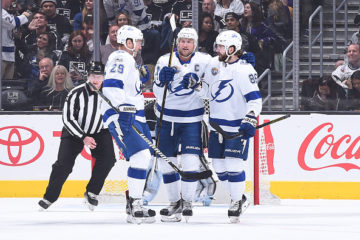2013 Fantasy Baseball: Taking a Close Look at Derek Holland


Derek Holland has long been a pitcher that has caught the attention of the fantasy community as a potential breakout candidate. And the 26-year-old lefty has gotten off to quite the hot start this year. In 60 innings so far, Holland has posted a 3.30 xFIP accompanied by a 22% strikeout-rate and 5.8% walk-rate. For those that drool over luck factors, his “luck-based” stats come in at league average. Holland sports a .307 batting-average-on-balls-in-play and a 73% strand rate so far this season.
Before we dive into any potential skepticism that should surface, it’s important that we give credit to some of the changes Holland has made to his pitch mix. [am4show have=’p3;p4;p7;’ guest_error=’Front Office’ user_error=’Front Office’ ]
Holland has shown this level of skill before. In 2011 Holland’s second half looks eerily similar to the start he’s enjoyed so far. Over 88.1 second-half innings, Holland recorded a 3.37 xFIP, a 76.5% strand rate (the best of his career over an elongated sample) a 22% strikeout-rate and 7.2% walk-rate. Digging deeper into that sample reveals what was really just an incredible September/October stretch of 32 innings.
| Month | K% | BB% | Strand Rate | BABIP | xFIP |
| July | 18.6% | 5.8% | 72.6% | .250 | 3.62 |
| August | 19.7% | 9.0% | 69.2% | .410 | 3.71 |
| Sept/Oct | 27.8% | 7.9% | 91.7% | .211 | 2.95 |
Taking a look at Holland’s strand rate, BABIP and outstanding strikeout rate; September and October of 2011 looks more like a period of peak mechanics, velocity and stuff rather than anything mirroring a sustainable breakout in the making. Let’s take a look at Holland’s fastball:
| Sample | Velocity | Usage % | Whiff/Swing % | BA/SLG/ISO/TAv |
| Sept/Oct 2011 | 95.65 mph | 58% | 28.79% | .145/.226/.081/.189 |
| Entire 2011 | 95.01 mph | 48% | 17.10% | .285/.409/.124/.282 |
| 2013 | 94.04 mph | 38% | 9.60% | .280/.366/.086/.251 |
Holland’s BABIP on his fastball so far in 2013 is .305 which is accompanied by a 2.08% HR/(FB+LD) on the pitch. Instead of calling that lucky, we will simply say “Holland seems to be at peak command at the moment, and given his history we can say that unless he has harnessed his old peak mechanics and peak command, we can expect that rate to rise closer to at least 8%”. If Holland can hold his ISO with the fastball under .400, that’s certainly a mark in the “breakout” box (given his secondary offering improvements which we will take a look at shortly).
Let’s step back for a second though and take a look at Holland’s overall growth since 2011 – Via Pitch F/X data from FanGraphs –
| Year | Chase % | Zone Swing % | O-Zone Contact % | Z-Contact % | SwStr % |
| 2011 | 27.8% | 60.2% | 64.8% | 89.4% | 7.9 |
| 2012 | 26.4% | 60.7% | 65.0% | 88.3% | 8.1 |
| 2013 | 33.8% | 62.2% | 61.8% | 88.1% | 10.3 |
Most encouraging in this data is Holland’s ability to generate a considerably larger amount of swings and misses on pitches outside the strike zone, whilst inducing a much greater number of swings. To put this in easier terms, take Holland’s 2011 for example. If Holland threw 1,000 pitches out of the strike zone, batters swung at 278 of them. Of those 278 swung at, only 181 generated contact by the batter. So out of a theoretical 1,000 pitches thrown out of the strike zone, batters swung and missed on 91 of them.
In 2013, if we were to extrapolate the current data out to the same 1,000 outside of the zone pitch total, 338 of them would be swung at and batters would miss on 130 of them.
130 divided by 91 equals 1.42 which equates to a 42% increase in pitches swung at and missed out of the strike zone for Holland in 2013 against his 2011 season. That’s quite remarkable.
What can be attributed to this increase? As we’ve already seen it’s not the fastball; and despite this report from Dallas Morning News writer Evan Grant how Holland has “rediscovered his changeup”, a meager 20.0% whiff-rate on the pitch per Brooks Baseball and a career .295 wOBA vs. left-handed-batters against a .340 career wOBA vs. right-handed-batters suggest there’s not enough evidence yet that the pitch is finally “back”. It begs the question “how good was his change-up originally?”
His slider has actually been his go-to pitch. The most impressive piece of data on the slider is Holland’s effectiveness with the pitch as a strikeout option against right-handed batters. Here’s a table illustrating that slider success vs. RHB.
| Sample Period | Usage % vs. in 2 strike counts | Whiff/Rate | BA/SLG/ISO/TAv |
| Sept/Oct 2011 | 22% | 57.14 % | .278/.667/.389/.313 |
| 2013 | 43% | 49.14% | .131/.295/.148/.171 |
Here is a visual chart per Baseball Prospectus of the Whiff/Rate on his slider vs. right-handed batters. Holland’s ability to sustain getting right-handed batters to chase the slider down at the their feet is going to be the most crucial factor if Holland wants to enjoy long term success and ultimately a breakout campaign.
Finally, the one concern we have with Holland going forward is his historical strand rate issues and home run problems. This is caused by his inconsistent mechanics. We finish on this note from Doug Thorburn – Baseball Prospectus’ mechanics expert and former pitching coach – from an email exchange.
“Grading Holland on mechanics involves an extra degree of difficulty. He was originally on the list for inclusion in the 2013 SP Guide(*), but he was so different start-to-start that I did not feel confident giving him grades for a full-season report card. I watched a half-dozen ballgames with disparate grades across the board. Holland’s balance varied from strong to weak depending on the day, as did his momentum, and the inconsistencies with timing and stability wreaked havoc on his repetition. He has looked stronger this season, with better consistency of mechanical timing and sequencing, as well as improvements to balance. I definitely like what I see, but Holland has teased us before, and I am cautiously optimistic about his chances to keep up the good work.” – Doug Thorburn, Baseball Prospectus
*Doug contributed mechanical profiles and analysis to Paul Sporer’s annual Starting Pitcher guide. You can find it here.
Cautiously optimistic is how we’d describe Holland’s chances to continue this as well. His repertoire has been much improved but with inconsistent mechanics, Holland is bound to regress a bit and struggle to maintain this hot start.
[/am4show]





